What is ABA Therapy?
Applied Behavior Analysis (ABA) therapy stands as a scientifically grounded approach dedicated to enhancing socially significant behaviors in children with autism spectrum disorder (ASD). Rooted in behavioral science and learning theory, ABA meticulously applies positive reinforcement and systematic interventions to foster communication, social skills, independence, and reduce challenging behaviors. This article explores the principles, methodologies, providers, and profound benefits of ABA therapy, supported by six decades of research and clinical application.
Foundations of Applied Behavior Analysis

What is Applied Behavior Analysis (ABA) therapy?
Applied Behavior Analysis (ABA) therapy is a scientifically based intervention designed to improve socially significant behaviors in individuals with autism spectrum disorder (ASD). It emphasizes understanding and modifying behavior through environmental interactions. ABA primarily uses positive reinforcement to encourage helpful behaviors like communication, social skills, self-care, and independence, while aiming to reduce challenging or harmful behaviors.
ABA programs are highly individualized, crafted by qualified professionals such as Board Certified Behavior Analysts (BCBAs). Methods can include discrete trial training, pivotal response treatment, and naturalistic models. Interventions are data-driven, with continuous assessment ensuring therapy adapts to the child's evolving needs.
Scientific basis and historical evolution
Rooted in principles of learning and behavior science, ABA has been applied and studied since the 1960s. Over six decades, it has evolved to include comprehensive models like Early Intensive Behavioral Intervention (EIBI) and the Early Start Denver Model (ESDM), which target varied developmental domains. These evidence-based approaches are regarded as the gold standard by health authorities in North America.
Recent large-scale research and meta-analyses confirm ABA’s effectiveness in improving cognitive function, language, adaptive behavior, and social skills. While mostly positive, the research landscape reveals a need for more rigorous long-term studies and broader outcome measures, such as quality of life assessments.
Core goals and outcomes
ABA therapy aims to increase functional, socially important behaviors and decrease behaviors that hinder development or daily functioning. Goals are tailored to each child and often focus on communication, social interaction, self-care, motor and play skills, and academic achievements.
Typical outcomes include improved language and cognitive skills, enhanced socialization, greater independence in daily living activities like dressing and hygiene, and reduced problematic behaviors. Early intervention—ideally before age five—and sustained therapy over 12 to 24 months are linked to the most substantial gains.
ABA also fosters emotional benefits for families by improving communication and reducing daily frustrations. The therapy’s adaptability across multiple settings such as home, clinics, and schools supports generalization of skills, promoting lasting progress.
| Aspect | Description | Notes |
|---|---|---|
| Definition | Science-based behavior intervention for ASD | Uses reinforcement and behavior principles |
| Historical Roots | Established since the 1960s | Includes models like EIBI and ESDM |
| Professional Oversight | Developed by BCBAs | Ensures individualized and evidence-driven programming |
| Core Objectives | Increase helpful behaviors; decrease harmful behaviors | Targets communication, social, adaptive, and academic skills |
| Documented Outcomes | Gains in cognition, language, socialization, adaptive behavior | Strongest when started early and provided intensively |
| Research Gaps | Limited large-scale, long-term, and quality of life studies | Highlights need for ongoing research |
Who Delivers ABA Therapy?

Professional Roles and Training
ABA therapy services are delivered by trained clinicians with specialized expertise in applied behavior analysis. The primary professionals include Board Certified Behavior Analysts (BCBAs), who design and oversee individualized treatment plans, and Registered Behavior Technicians (RBTs), who implement therapy under BCBA supervision. This professional structure ensures adherence to evidence-based methods and fidelity to intervention protocols. BCBAs typically hold graduate-level training and certification that validate their competence in behavioral assessment and intervention.
Organizations and Service Providers
A wide array of organizations provide ABA therapy, ranging from dedicated ABA clinics to comprehensive developmental centers. Examples include LEARN Behavioral and Kyo, which deploy multidisciplinary teams of behavior analysts and technicians. Centers like the Center for Speech, Language, Occupational Therapy, and ABA serve children aged 2 to 12, providing coordinated support spanning multiple developmental domains. These organizations emphasize customized, data-driven treatments tailored to each child’s needs.
Settings for ABA Services
ABA therapy is delivered across diverse environments to maximize generalization of skills. Common settings include homes, clinics, and schools. Naturalistic models promote learning in everyday contexts, and peer-involved approaches within group or classroom settings foster social interaction. Flexibility in venue permits integration of therapy into daily routines, enhancing both consistency and effectiveness. Families often collaborate with providers to ensure skill transfer between clinical sessions and home life.
| Provider Type | Role | Training and Certification |
|---|---|---|
| Board Certified Behavior Analyst (BCBA) | Designs and supervises individualized ABA plans | Graduate degree and board certification in behavior analysis |
| Registered Behavior Technician (RBT) | Implements ABA therapy under BCBA supervision | Credentialing focused on ABA techniques and ethics |
| ABA Service Organizations | Provide multidisciplinary teams and treatment programs | Includes certified behavior analysts, therapists, and support staff |
In summary, ABA therapy is delivered by qualified professionals guided by rigorous training and certification standards. These providers work within organizations offering specialized services across various settings, ensuring therapy is accessible, individualized, and integrated into the child’s daily environment.
Key Principles Underpinning ABA Therapy
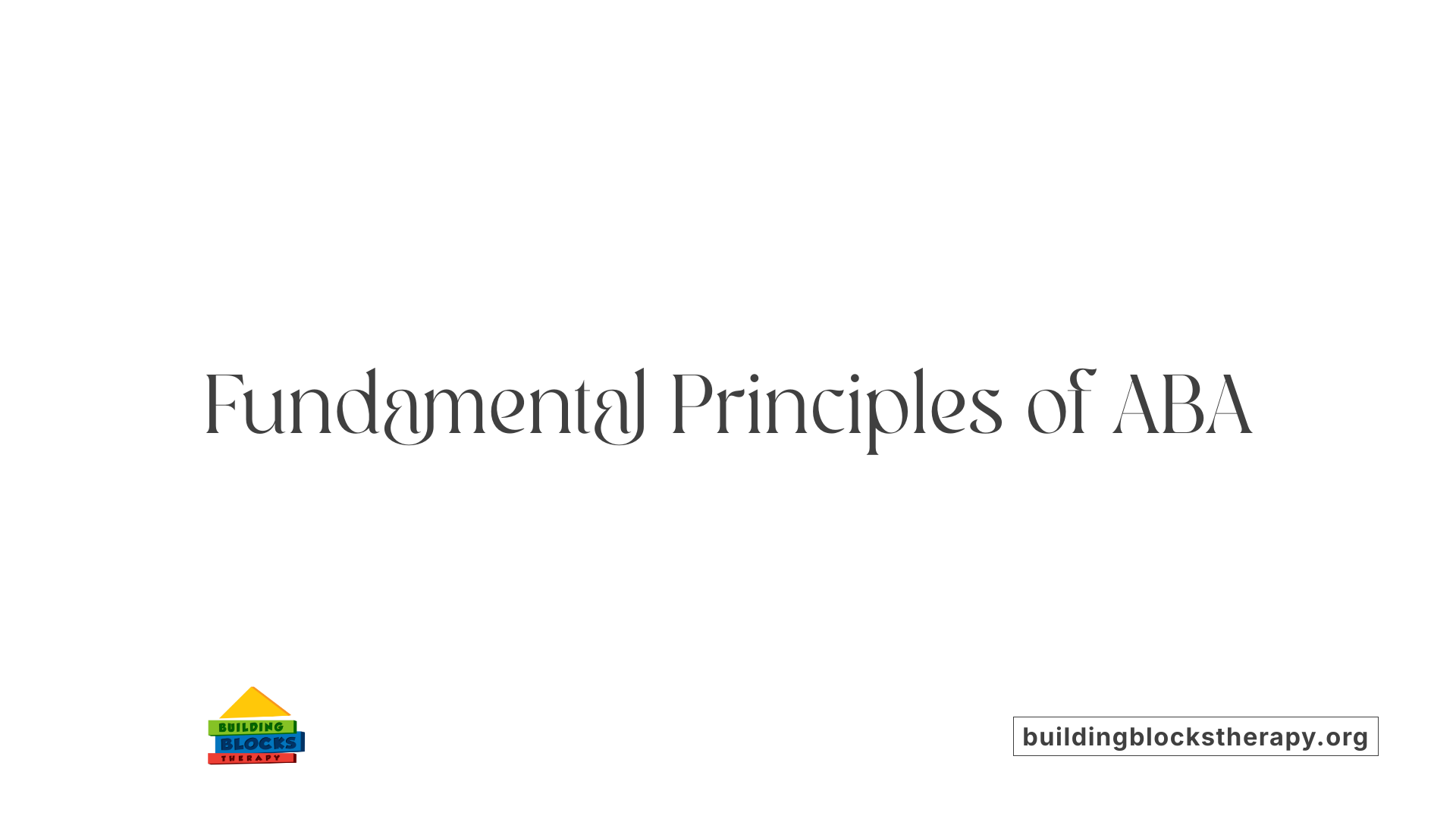
What are the key principles behind ABA therapy?
Applied Behavior Analysis (ABA) is grounded in behavioral science, focusing on how environmental factors influence observable and measurable behaviors. A core concept within ABA is the ABC model—Antecedent, Behavior, Consequence—which explains that behavior occurs in response to antecedent events and is shaped by the consequences that follow.
Positive reinforcement plays a crucial role in ABA, wherein desirable behaviors are encouraged through rewards such as verbal praise, tokens, or other motivators. Conversely, it aims to decrease harmful or impeding behaviors by altering their consequences or preventing triggers.
ABA employs a systematic, data-driven approach. Behavior analysts collect continuous data to evaluate progress and adjust interventions accordingly. This iterative process ensures that therapy is individualized and focused on meaningful outcomes.
Moreover, ABA uses strategies like task analysis, prompting, shaping, and fading to teach new skills progressively while promoting generalization across settings like home, school, and community. These techniques help children gain independence and improve various areas including communication, social skills, and daily living tasks.
In summary, ABA's fundamental principles revolve around understanding and modifying behavior through environmental manipulation, reinforcement, and continual assessment, with the goal of fostering socially significant improvements tailored to the individual's needs.
Techniques Commonly Employed in ABA Therapy

What techniques are commonly used in ABA therapy?
Applied Behavior Analysis (ABA) therapy uses a variety of proven techniques to improve behaviors and skills in children with Autism Spectrum Disorder (ASD). A central method is positive reinforcement, where desirable behaviors are immediately followed by rewards such as verbal praise, tokens, or stickers. This encourages children to repeat those helpful behaviors.
Another widely used technique is Discrete Trial Training (DTT). This structured approach breaks learning down into clear, manageable steps. It involves giving a clear instruction, prompting a response, providing reinforcement for correct answers, and applying corrections for errors. DTT is highly focused on teaching specific skills like communication or social behaviors in a systematic way.
Several other strategies complement these core methods. Modeling involves therapists demonstrating a behavior for children to imitate. Prompting provides cues to help initiate behaviors, which are then gradually faded to encourage independence. Chaining breaks down complex skills into smaller steps that are taught sequentially, such as learning to brush teeth or tie shoes by mastering each action in order.
Task analysis involves dissecting tasks into individualized teaching objectives. Techniques such as redirection help gently shift attention away from challenging behaviors, while script fading guides children through social interactions with decreasing adult support.
Together, these techniques form a comprehensive toolbox that is customized by Board Certified Behavior Analysts (BCBAs) to fit each child’s unique needs. The use of consistent, data-driven approaches ensures steady progress in skill acquisition and behavior improvement across different settings like home, school, or clinic.
| Technique | Description | Purpose/Use Case |
|---|---|---|
| Positive Reinforcement | Rewarding desirable behaviors immediately with praise or tokens. | Increase frequency of positive behaviors. |
| Discrete Trial Training | Structured teaching using clear instruction, prompting, and reward. | Teach specific, discrete skills systematically. |
| Modeling | Therapist demonstrates behavior for child to copy. | Promote imitation and social learning. |
| Prompting & Fading | Providing cues then removing support gradually. | Support learning while encouraging independence. |
| Chaining | Breaking tasks into sequential steps. | Enable mastery of complex skills step-by-step. |
| Task Analysis | Breaking tasks into smaller components. | Personalize and organize teaching objectives. |
These ABA techniques collectively enhance communication, social interaction, self-care, and daily living skills. Their flexibility and individualized application make ABA a scientifically grounded, effective therapy for children with ASD.
The Role of Early Intervention in ABA Therapy

Why is starting ABA therapy before age 4 or 5 important?
Early intervention with ABA therapy, ideally before the age of 4 or 5, plays a crucial role in maximizing developmental gains for children with autism spectrum disorder (ASD). Research consistently shows that initiating ABA during these critical developmental windows can lead to better language acquisition, social skills, and cognitive outcomes. Early exposure takes advantage of neuroplasticity—allowing children to more easily form new skills and habits.
How does early ABA impact language and social outcomes?
ABA therapy conducted early can significantly improve communication and social interaction skills. Studies demonstrate enhanced expressive language, better social engagement, and reductions in problem behaviors such as tantrums or anxiety. This early skill development fosters greater independence and smoother transitions into inclusive educational settings. Furthermore, early ABA tends to boost adaptive behaviors critical for daily functioning, such as following instructions and self-care.
What are the critical developmental windows for ABA intervention?
The early preschool years represent a vital window when children’s brains are most responsive to behavioral interventions. During this period, systematic and individualized ABA programs can effectively target the foundational skills that form the basis for later complex abilities. Intervening in this timeframe helps prevent skill gaps from widening and addresses delays before they become more ingrained.
In summary, starting ABA therapy early is supported by a large body of evidence and is associated with better long-term outcomes in communication, socialization, and adaptive functioning. These benefits highlight the importance of early diagnosis and rapid initiation of ABA services, enabling children with ASD to reach their full potential.
Individualized and Comprehensive Treatment Planning

Role of Board Certified Behavior Analyst (BCBA)
A Board Certified Behavior Analyst (BCBA) plays a central role in designing and supervising ABA programs. This expert conducts thorough assessments to understand the unique strengths, challenges, and needs of each child with Autism Spectrum Disorder (ASD). The BCBA ensures that treatment plans are grounded in evidence-based practices and customized to maximize developmental progress.
Program Tailoring Based on Strengths, Challenges, Goals
ABA programs are highly individualized, focusing on each child's specific behavioral and developmental goals. These may include communication, social skills, self-care, play, motor skills, and academic abilities. Treatment strategies such as positive reinforcement, prompting, and skill generalization are adapted to suit the child's preferences and learning style. Programs evolve over time, responding to improvements and new challenges, making the treatment dynamic and relevant.
Ongoing Assessment and Adaptation
Continuous monitoring and data collection are essential components of ABA therapy. The BCBA regularly evaluates the child's progress, adjusting intervention intensity, techniques, and goals accordingly. This ongoing assessment ensures that the therapy remains effective and aligned with the child's developmental trajectory. Flexibility in the program allows for timely modifications that address emerging needs, helping to sustain long-term improvements across settings such as home, school, and community.
Evidence Supporting ABA Therapy Effectiveness

What do meta-analyses reveal about ABA therapy outcomes?
Meta-analyses consistently show that Applied Behavior Analysis (ABA) therapy leads to significant improvements in children with Autism Spectrum Disorder (ASD). Studies report positive behavioral changes in 63% to 88% of participants, highlighting ABA's effectiveness in enhancing various developmental domains.
How does ABA improve IQ, communication, and adaptive behavior?
Research indicates strong effects of ABA on intellectual and communication skills. Specifically, ABA shows very effective results in boosting IQ (effect size g=0.740) and moderate to very effective improvements in language and communication (g ranging from 0.597 to 0.742). Adaptive behaviors—including socialization and daily living skills—also improve moderately (g between 0.422 and 0.650). These gains contribute to better inclusion in mainstream settings and reductions in problematic behaviors.
ABA also supports skill acquisition like expressing needs, following instructions, and independent living tasks, fostering confidence and reducing caregiver burden.
What are the research limitations and the need for larger, rigorous studies?
Despite promising outcomes, most ABA research involves small sample sizes and single-case designs, limiting generalizability. Only about 4% of studies are large-scale randomized controlled trials, underscoring a crucial need for more rigorous and longer-term investigations. Additionally, outcome measures related to quality of life and long-term effects into adulthood remain underexplored.
This gap presents a challenge for fully understanding how ABA benefits evolve over time and across different life stages.
| Aspect | Findings | Additional Details |
|---|---|---|
| Meta-analyses effectiveness | 63%-88% participants show improvements | Consistent improvements in behavior and skills |
| IQ and communication | Effect sizes: IQ (g=0.740), communication (g=0.597-0.742) | Strong positive developmental impact |
| Adaptive behavior | Moderate improvements (g=0.422-0.650) | Includes social skills and daily living activities |
| Research scope | Limited large-scale RCTs (4%) | Need for more rigorous, long-term studies |
| Outcome gaps | Quality of life and adult outcomes under-investigated | Important for understanding lasting benefits |
Domains of Improvement Through ABA
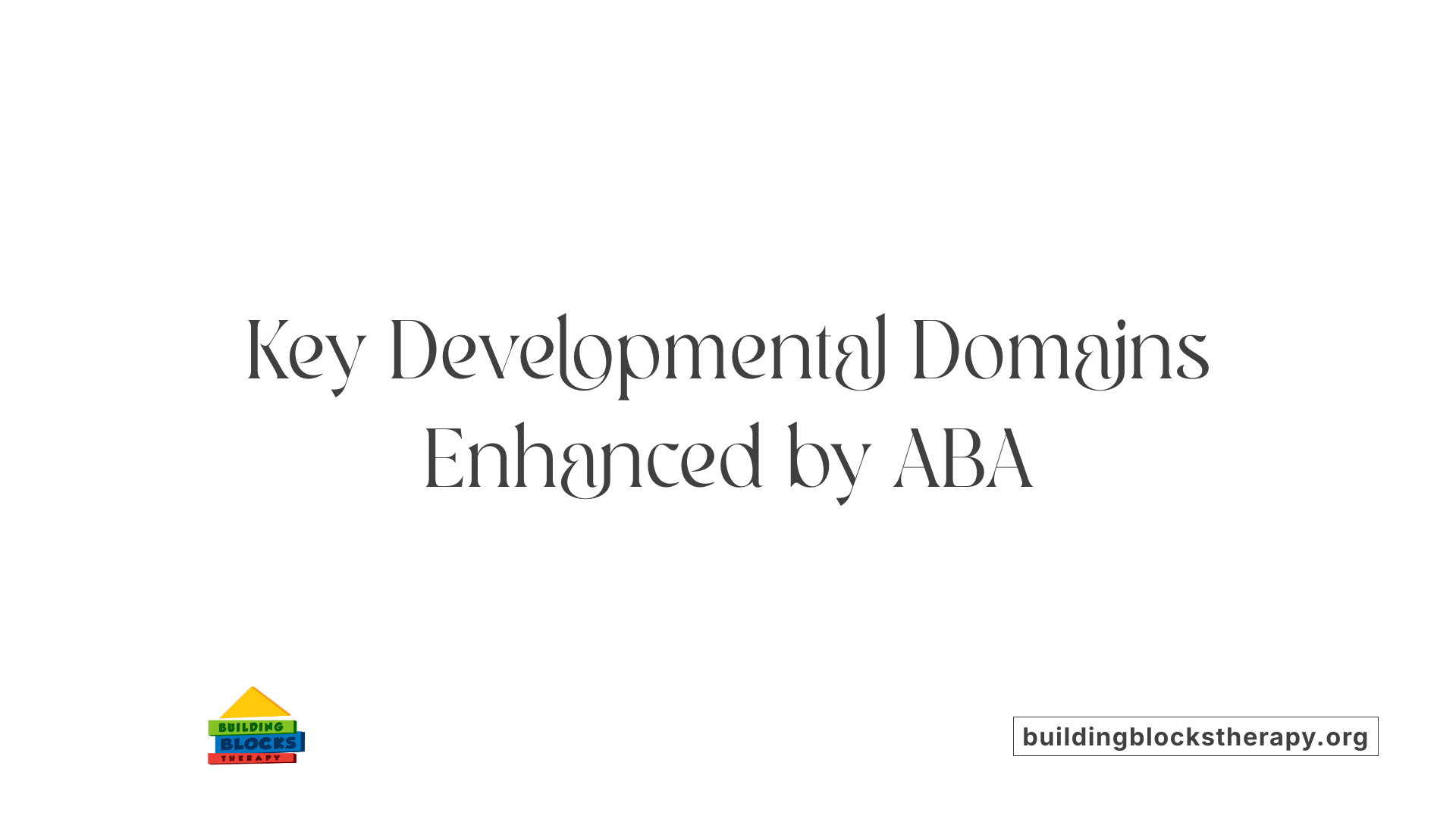
Communication and language
ABA therapy is highly effective in enhancing communication and language skills in children with ASD. Techniques such as positive reinforcement, use of visual schedules, and prompting help children express needs, follow instructions, and build verbal skills. Research shows moderate to very strong improvements in expressive language and communication abilities, supporting better relationships and reduced frustration.
Social skills and peer interaction
ABA interventions focus on structured social behaviors, including greetings, turn-taking, making eye contact, and peer engagement, allowing children to develop essential social competencies. Programs like the Early Start Denver Model promote emotional and social development by teaching these skills within naturalistic and peer-involved settings, which research indicates lead to improved socialization and peer connections.
Daily living and adaptive behaviors
ABA targets self-reliance by teaching daily living skills such as brushing teeth, tying shoes, and completing self-care routines. These adaptive behaviors improve confidence and independence, reducing reliance on caregivers. Meta-analyses demonstrate moderate gains in adaptive behavior, facilitating inclusion in regular school settings and overall quality of life improvements.
| Domain | Examples of Skills Developed | Research Insights |
|---|---|---|
| Communication and Language | Expressive language, following instructions | Moderate to strong improvements in language outcomes |
| Social Skills and Interaction | Eye contact, peer communication, turn-taking | Gains in socialization and peer connections |
| Daily Living and Adaptive | Self-care, motor skills, independence | Moderate improvements in adaptive behavior |
Behavioral Challenges Addressed by ABA

Reduction of Problematic Behaviors Such as Tantrums and Separation Anxiety
Applied Behavior Analysis (ABA) effectively reduces problematic behaviors commonly seen in children with Autism Spectrum Disorder (ASD), including tantrums and separation anxiety. Structured ABA sessions focus on identifying triggers and using positive reinforcement strategies to decrease these challenging behaviors. Research shows that interventions break down goals into manageable steps and employ immediate reinforcement to support behavioral improvements.
Improvement in Emotional Regulation
ABA therapy also targets emotional regulation, teaching children skills to manage frustration, anxiety, and other difficult emotions. Techniques such as response system arrangement and direct teaching help children develop coping strategies. This focus not only reduces emotional outbursts but also enhances overall social and communicative functioning.
Generalization of Skills Across Settings
A critical feature of ABA is promoting the generalization of learned skills beyond the therapy sessions. Parental involvement plays a pivotal role in ensuring children apply communication and social skills at home, school, and community settings. Naturalistic and peer-involved models of ABA further support this transfer, helping maintain gains in emotional regulation and reducing problematic behaviors in everyday environments.
ABA Therapy Settings and Models
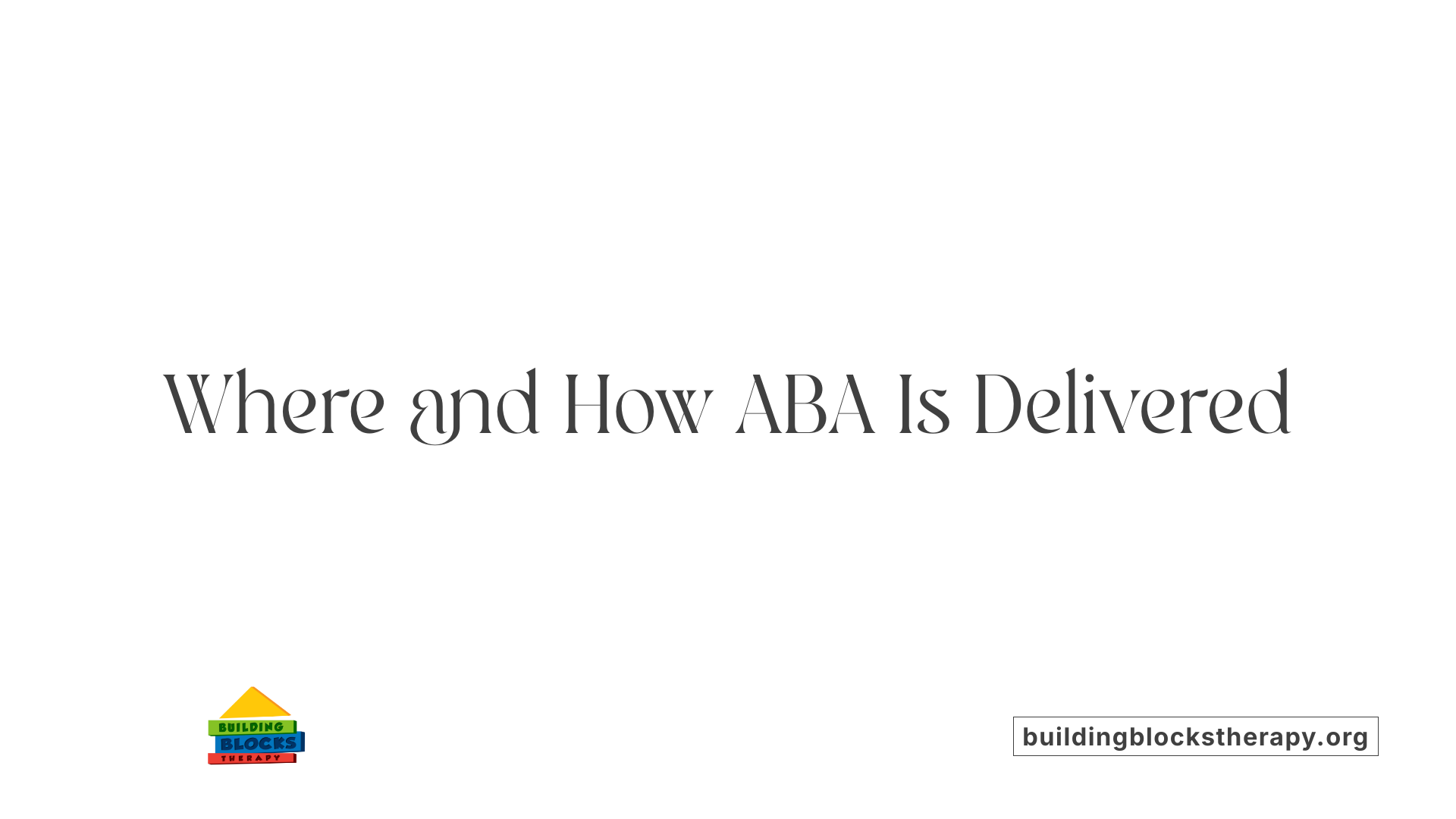
What are the common settings for ABA therapy interventions?
ABA therapy is delivered across various settings, including the home, clinic, and school environments. Each setting offers unique opportunities for intervention:
- Home-based interventions allow for therapy in a natural environment, enabling children's skills to generalize across daily routines with family involvement.
- Clinic-based interventions provide structured therapy with specialized staff and resources, facilitating targeted skill acquisition.
- School-based interventions focus on socialization and academic skills within peer groups and educational contexts.
This multi-setting approach supports comprehensive development and skill generalization.
How are naturalistic and peer-involved models influencing ABA delivery?
Recently, naturalistic and peer-involved models have gained attention in ABA therapy. These approaches emphasize learning in typical social contexts:
- Naturalistic models integrate teaching moments into everyday activities and play, increasing motivation and spontaneous skill use.
- Peer-involved models encourage interactions with typically developing peers to enhance social skills, communication, and inclusion.
Such models foster more generalized and socially meaningful outcomes, bridging therapy with real-life experiences.
What advantages arise from delivering ABA across multiple settings?
Providing ABA therapy across home, clinic, and school settings offers several benefits:
- Improved skill generalization: Skills learned in one environment transfer more effectively to others.
- Consistent reinforcement: Coordinated approaches ensure consistent behavior support throughout the child's day.
- Family and peer engagement: Involving caregivers and peers enhances motivation and social competence.
- Rich data collection: Diverse settings provide comprehensive information to tailor and adapt interventions.
Together, these factors contribute to more holistic and effective behavior change and development in children with ASD.
Parental and Caregiver Involvement in ABA
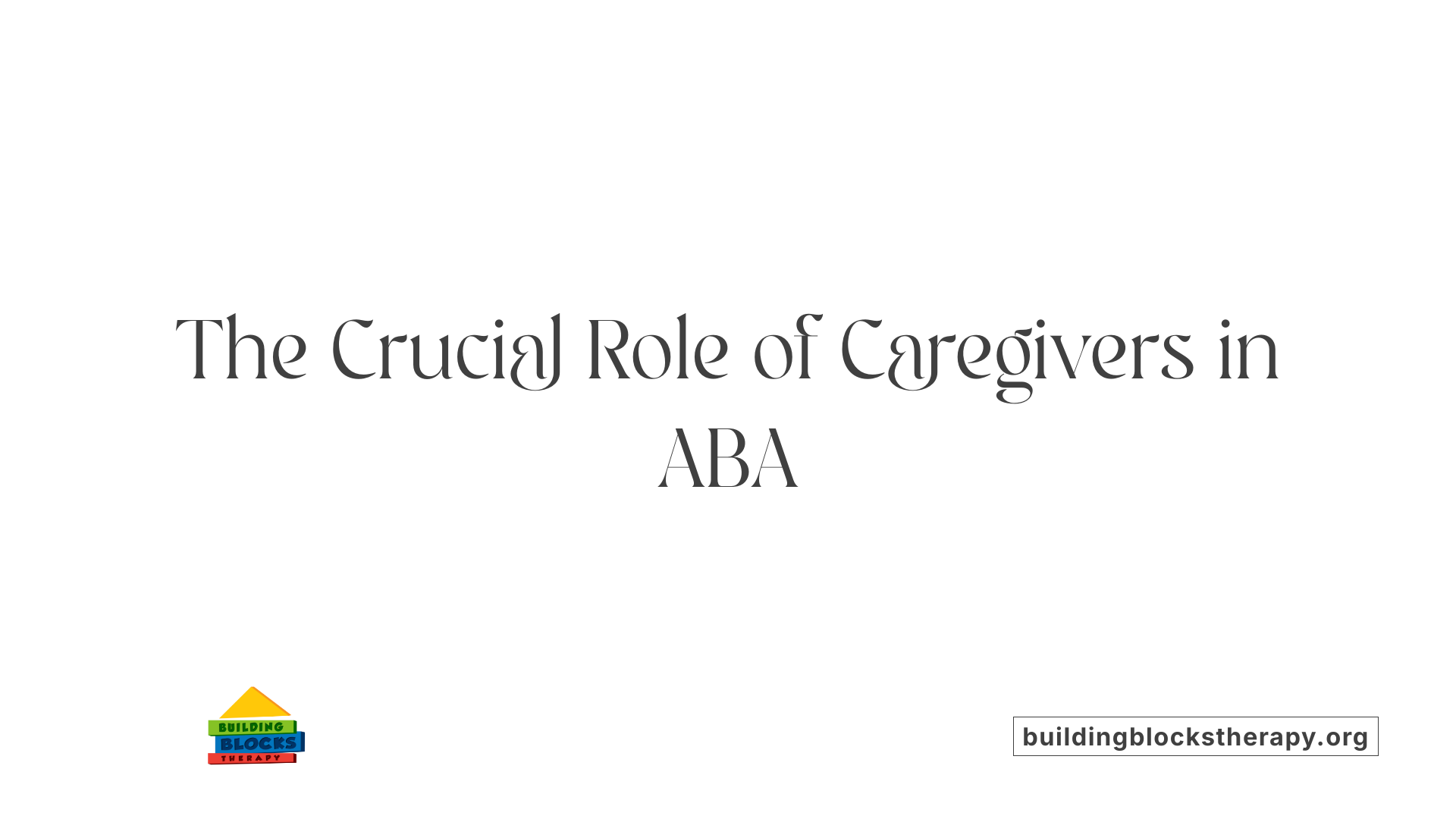
Why is caregiver participation important in ABA therapy?
Caregiver participation is essential in Applied Behavior Analysis (ABA) therapy because it directly supports and enhances the child's progress. Parents and caregivers help reinforce skills learned during therapy sessions by consistently applying strategies in the home environment. Their involvement fosters a collaborative approach that strengthens treatment outcomes and provides emotional support for the child.
How does skill generalization to the home environment benefit from caregiver involvement?
Skills developed in structured therapy sessions need to be generalized to daily routines to ensure meaningful and lasting benefits. Caregivers play a critical role in this process by practicing learned behaviors such as communication, social interaction, and self-care skills outside therapy settings. This extension helps maintain and improve gains, leading to sustained behavioral improvements.
What is the impact of caregiver involvement on consistency and progress in ABA?
Consistency in applying ABA techniques is crucial for effective learning and behavior change. Active caregiver participation ensures that interventions continue throughout the child's daily life, reducing frustration and promoting smoother skill acquisition. Additionally, engaged caregivers can provide important feedback to therapists, enabling personalized adjustments that optimize progress.
Parental and caregiver involvement is therefore a vital component of ABA therapy, positively influencing outcomes by promoting consistency, supporting skill generalization, and enhancing the child’s overall development and family dynamics.
Insurance Coverage and Access Challenges

Variability in insurance mandates
Insurance coverage for ABA therapy varies significantly across regions and policies. While some states mandate coverage for Medicaid recipients, private insurance requirements differ widely depending on state laws and individual insurance policies. This inconsistency often leaves families uncertain about their eligibility and available benefits.
Barriers to service access
Access to ABA services is frequently hindered by several challenges. Families may face difficulties in finding qualified providers, navigating complex insurance claims, and dealing with limited provider availability. Additionally, disparities in insurance coverage can exacerbate these barriers, making it harder for some children to receive timely and adequate treatment.
Impact on therapy continuity and intensity
These insurance and access issues directly affect the continuity and intensity of ABA therapy. Studies show that despite evidence supporting high-intensity, long-duration interventions, many children receive fewer therapy hours than recommended. Interruptions or reductions in therapy doses can limit the potential benefits, contributing to high dropout rates and reduced long-term effectiveness.
Addressing these challenges requires coordinated efforts among healthcare providers, insurance companies, and policymakers to improve coverage consistency and streamline access. Ensuring families have adequate support and resources can enhance therapy adherence and ultimately improve outcomes for children with ASD.
Therapy Intensity and Duration
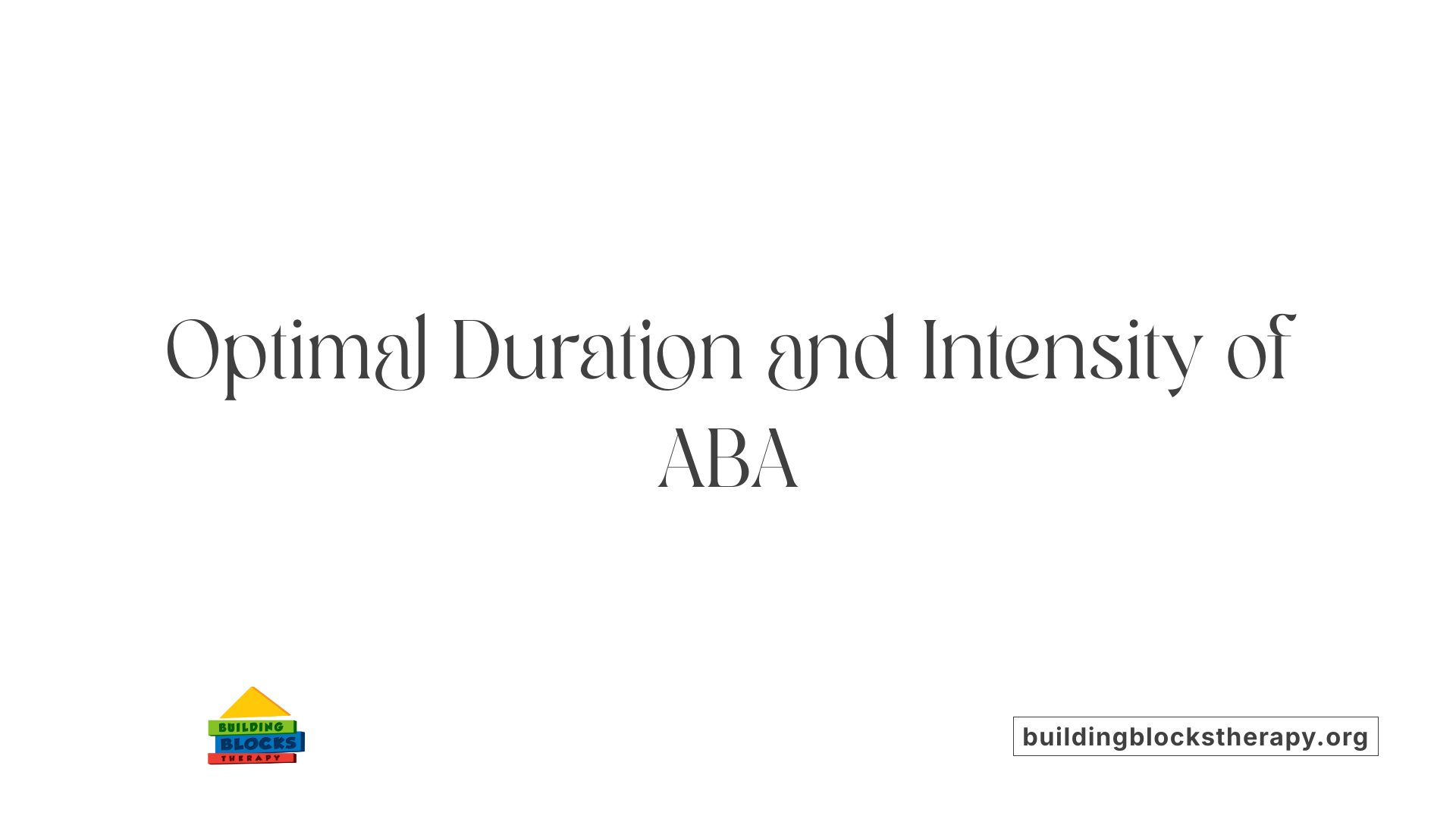
What are the recommended hours and duration for ABA therapy?
ABA therapy typically involves intervention over a period of 12 to 24 months, with an average of around 20 or more hours per week. This timeframe and intensity are suggested to yield optimal developmental progress in children with ASD. Early intervention, especially before age 5, is crucial to maximize language, social, and cognitive gains.
Is there a dose-response relationship, and are there diminishing returns?
Research supports a dose-response relationship where increased hours of ABA therapy correlate with better outcomes in areas such as communication, adaptive behavior, and cognitive abilities. However, recent studies indicate that simply increasing therapy hours beyond a certain threshold does not always produce proportionally better results. This suggests diminishing returns at very high intensities, highlighting the importance of balancing therapy quality and dose.
What are the real-world challenges in maintaining recommended intensity?
In practice, many community settings struggle to deliver the recommended intensity and duration of ABA therapy. Intensity often falls short due to factors such as limited insurance coverage, service access barriers, and high discontinuation rates. These issues can reduce the potential benefits of therapy, underscoring the need for better implementation strategies that support sustained, high-quality intervention tailored to individual needs.
Long-Term Outcomes and Quality of Life Considerations

Sparse research on adult outcomes
Though Applied Behavior Analysis (ABA) has a solid reputation for improving various skills in children with Autism Spectrum Disorder (ASD), research focusing on long-term outcomes, especially into adulthood, remains limited. Few studies have followed participants beyond childhood, leaving gaps in understanding how early intervention impacts lifelong functioning and independence.
Current gaps in measuring subject quality of life
Despite ABA's demonstrated success in improving adaptive behavior, communication, and social skills, measures of quality of life (QoL) specific to the individual undergoing therapy are rarely included in research. Most existing studies emphasize observable skills and behavior changes but often overlook the broader emotional, social, and psychological wellbeing of individuals, which are critical for assessing treatment effectiveness holistically.
Importance of generalization and independence
A strong focus of ABA is the generalization of skills learned during therapy to natural settings like home and school, which is essential for meaningful daily life improvements. Achieving lasting independence, such as managing self-care and socially appropriate behaviors, is fundamental to enhancing overall quality of life. Encouragingly, parental involvement and tailored interventions support transfer of skills, yet systematic evaluation of how well these skills persist and contribute to autonomous living is still an area needing further research.
Comparison of ABA Techniques and Variability in Results

Are there mixed findings on the superiority of specific methods within ABA?
Research comparing various ABA techniques reveals mixed outcomes regarding which approach may be superior. Approximately half of published studies indicate that one method might outperform another in certain contexts, but overall, evidence does not conclusively favor any single method as consistently better. This variability suggests that no one technique universally applies best across all children with ASD.
What are examples of prominent ABA techniques like Discrete Trial Training and Pivotal Response Treatment?
Two well-known ABA methodologies are Discrete Trial Training (DTT) and Pivotal Response Treatment (PRT). DTT is a structured, adult-led approach focusing on breaking skills into discrete steps with repeated trials and reinforcement. In contrast, PRT emphasizes naturalistic teaching in everyday settings, promoting motivation through child choice and responsive reinforcement. Additionally, the Early Start Denver Model (ESDM) integrates ABA principles in a developmental, play-based format, targeting younger children. Each method employs prompting, reinforcement, and functional communication strategies tailored to developmental needs.
Why is an individualized approach important in ABA treatment?
Given the diversity in techniques and varied outcomes, individualizing ABA programs to match the unique strengths, challenges, and preferences of each child is crucial. Behavior analysts customize interventions based on ongoing assessments, adapting methods as children progress to maximize benefits. This tailored approach helps address specific behavioral goals effectively rather than relying on a uniform treatment protocol, thus enhancing the likelihood of meaningful improvements across communication, socialization, and adaptive behaviors.
ABA Therapy’s Contribution to Emotional and Social Development
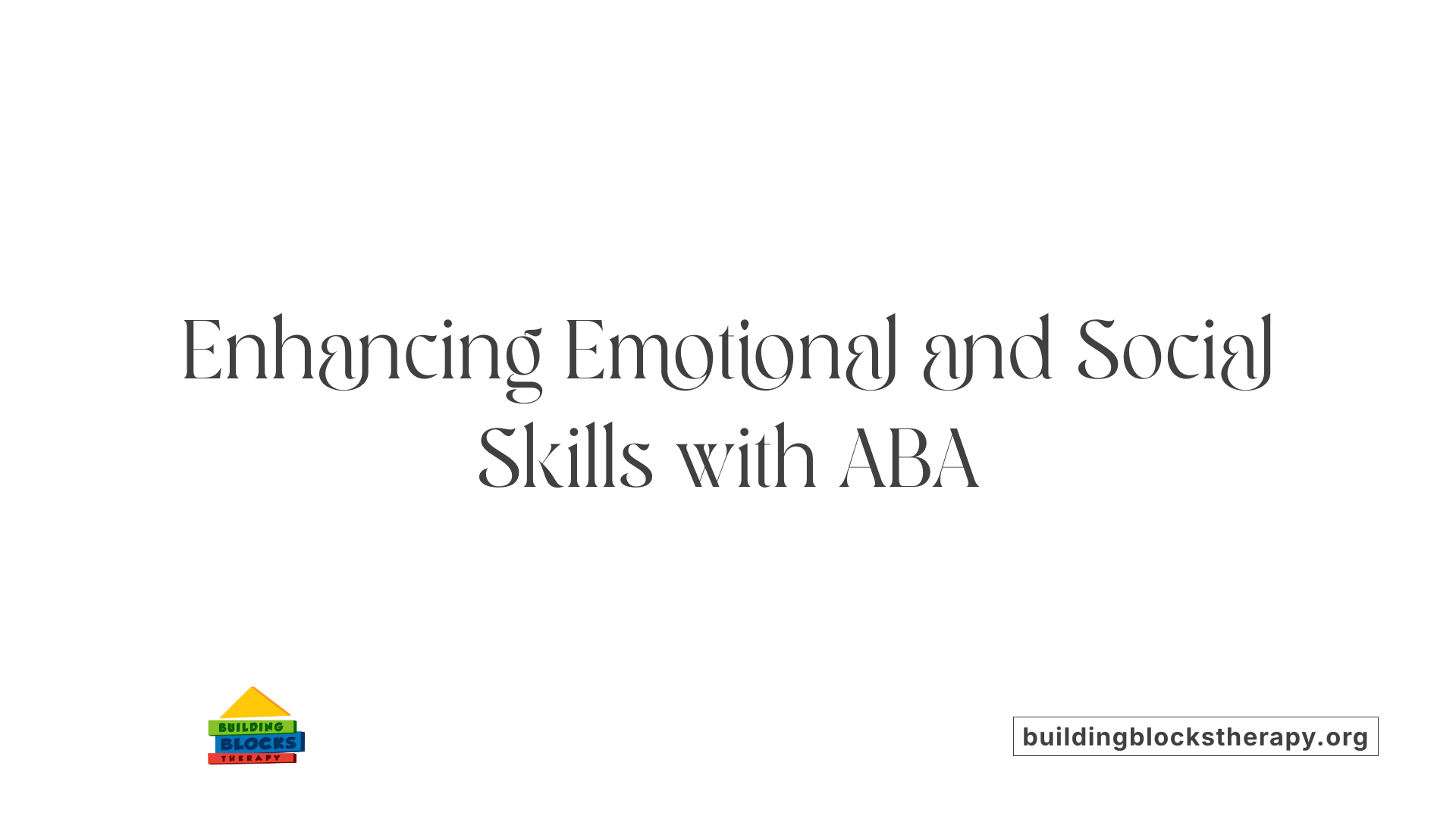
How Does ABA Enhance Emotional Regulation in Children with ASD?
ABA therapy employs structured teaching methods that break down emotional and behavioral goals into manageable steps. Techniques such as immediate reinforcement help children recognize and control emotional responses. By consistently applying positive reinforcement for desired emotional behaviors, ABA supports children in managing feelings like frustration and anxiety. This process enables gradual improvement in emotional regulation, making it easier for children to cope with challenging situations.
In What Ways Does ABA Build Peer Social Skills?
ABA focuses on teaching core social behaviors essential for successful peer interactions. These include greetings, turn-taking, and making eye contact, which are systematically taught through naturalistic and peer-involved models. Incorporating visual aids like picture cards or visual schedules supports communication, fostering social connections and reducing social barriers. The therapy also encourages the generalization of social skills across settings, promoting smoother social integration at home, school, and community.
How Does ABA Reduce Anxiety and Frustration?
By improving communication and promoting independence in daily tasks such as expressing needs and following instructions, ABA helps alleviate common sources of anxiety and frustration for children with ASD. Structured sessions reduce separation anxiety and other challenging behaviors by providing predictable routines and clear expectations. Parental involvement in ABA programs further supports emotional well-being by ensuring learned skills effectively transfer to the home environment, strengthening relationships and reducing daily stressors.
Overall, ABA therapy offers significant emotional and social development benefits. It enhances self-regulation, nurtures positive peer relations, and mitigates anxiety-related behaviors through individualized, consistent interventions that adapt as the child progresses.
Tools and Supports Used in ABA
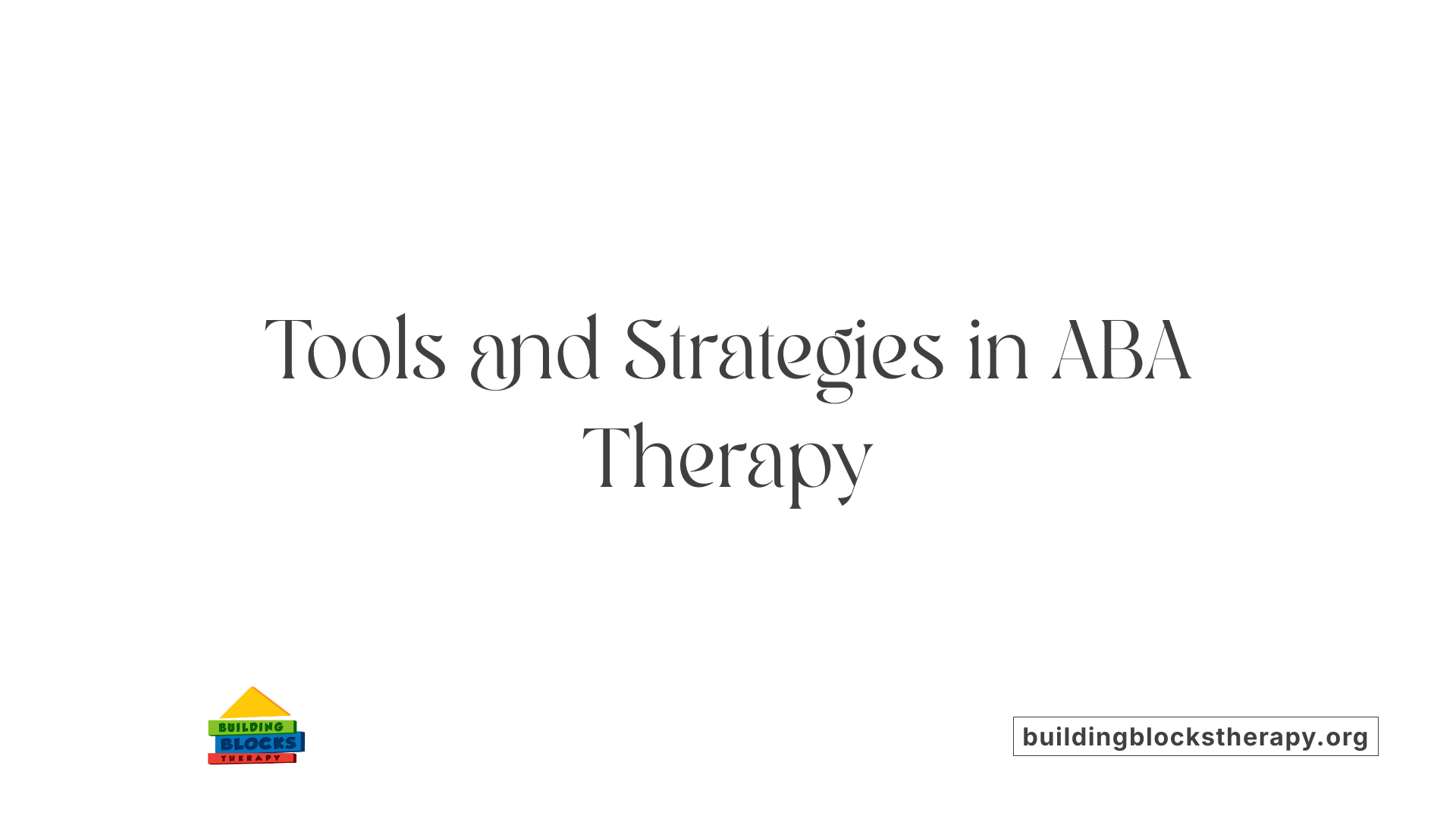
What Tools Are Commonly Used in ABA Therapy?
ABA therapy employs a variety of practical tools to enhance learning and communication for children with Autism Spectrum Disorder (ASD). One widely used aid is picture cards and visual schedules. These tools serve as visual prompts that help children understand daily routines, anticipate transitions, and communicate more effectively. Visual supports reduce frustration and encourage smoother interactions both at home and in educational settings.
How Does Positive Reinforcement Work in ABA?
Positive reinforcement is central to ABA and involves rewarding desired behaviors to encourage their repetition. Common reinforcement items include verbal praise, stickers, and tokens. These rewards are often given immediately after a correct behavior to strengthen the association between the behavior and its positive outcome. This approach motivates children to engage more consistently in target skills and behaviors.
What Structured Behavioral Strategies Are Used?
ABA also incorporates structured behavioral teaching strategies to develop essential social and communication skills. For example, behaviors like greetings, turn-taking, and making eye contact are systematically taught during sessions. These structured approaches break down complex skills into manageable steps, making learning more accessible and effective. Teachers and therapists tailor these methods to individual needs, ensuring progress is steady and meaningful.
By combining visual aids, positive reinforcement, and structured teaching strategies, ABA therapy provides a supportive framework that fosters skill acquisition and improved social interaction for children with ASD.
The Science and Evolution of ABA
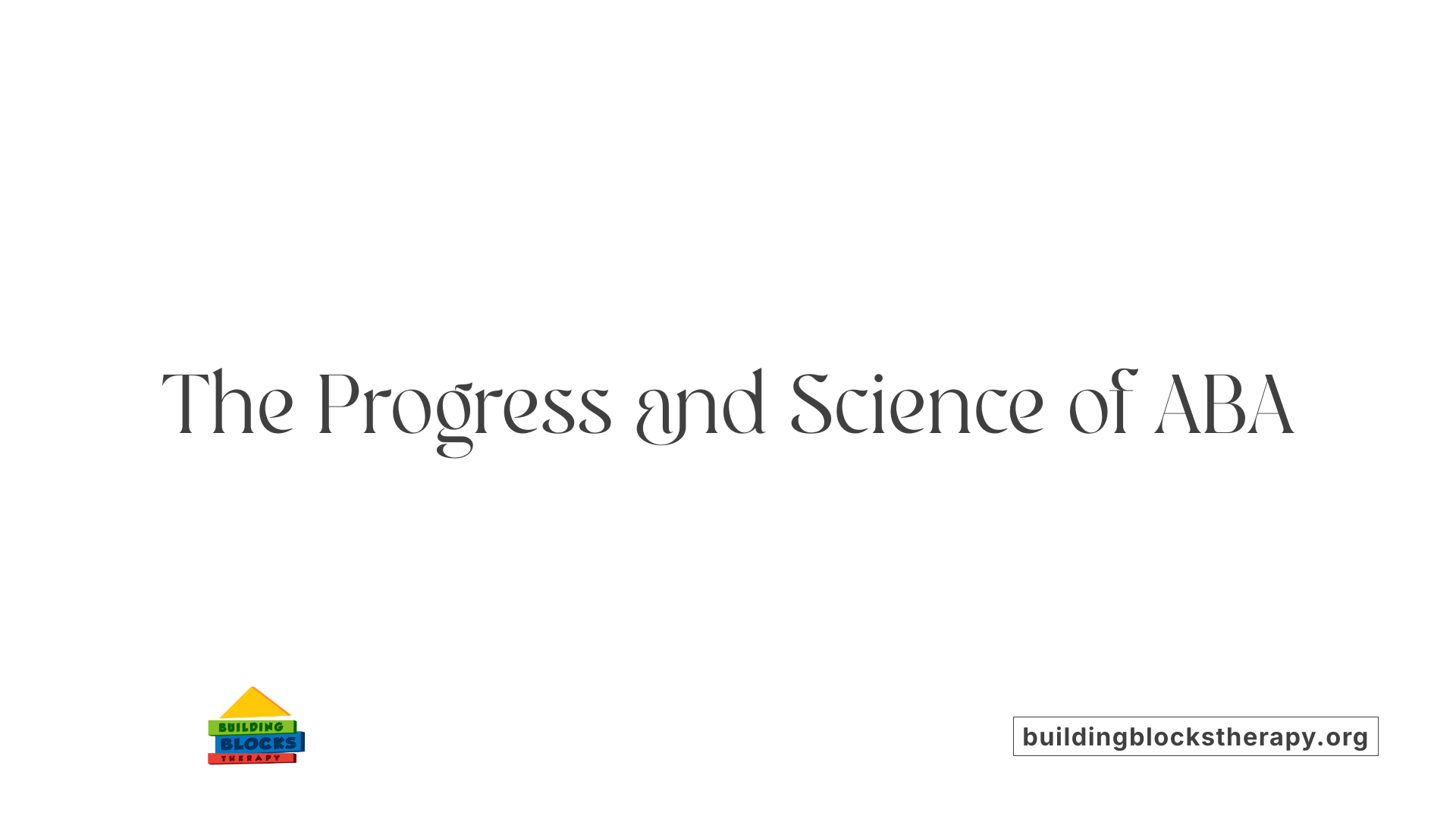
Over 60 Years of Research and Clinical Application
Applied Behavior Analysis (ABA) is a science-based treatment rooted in learning and behavior science, with origins dating back to the 1960s. Over six decades, ABA has evolved through continuous research and clinical application, establishing a robust evidence base for its use in autism spectrum disorder (ASD) intervention. This long-standing legacy underscores ABA's focused approach to increasing helpful behaviors and decreasing harmful or impeding ones.
Adaptation of Comprehensive Treatment Models like EIBI and Early Start Denver Model
Throughout its evolution, ABA has expanded into comprehensive treatment models tailored to various developmental needs. Notably, Early Intensive Behavioral Intervention (EIBI) applies intensive, early-start strategies designed to maximize developmental gains. The Early Start Denver Model (ESDM) blends ABA principles with developmental and relationship-based approaches, emphasizing naturalistic interactions. Other models like LEAP further diversify ABA’s applications to target communication, social, cognitive, and adaptive outcomes across settings such as home, clinic, and school.
Endorsements by Professional Authorities
ABA’s effectiveness and rigor have led to its recognition as a 'gold standard' treatment for ASD by health authorities in North America. Esteemed organizations, including the US Surgeon General and the American Psychological Association (APA), endorse ABA as an evidence-based best practice. These endorsements are grounded in over 20 scientific studies demonstrating improvements in cognition, language, daily living skills, and social functioning. This professional consensus highlights ABA’s pivotal role in contemporary ASD care and intervention.
Benefits of ABA for Families

How Does ABA Improve Communication Within Families?
ABA therapy uses behavior modification techniques to enhance children's communication skills, enabling them to express needs and understand instructions better. Tools such as picture cards and visual schedules support this progress, leading to clearer communication between children and family members. Improved communication helps reduce misunderstandings and fosters stronger connections at home.
How Does ABA Therapy Reduce Daily Frustrations?
By teaching children skills to express themselves and complete daily tasks like brushing teeth or tying shoes, ABA increases their independence. This lowers the frequency of tantrums and frustration-related behaviors, making everyday routines smoother for both children and caregivers. Immediate reinforcement and breaking down complex goals into manageable steps contribute to these improvements.
In What Ways Does ABA Strengthen Familial Relationships and Dynamics?
ABA therapy emphasizes parental involvement, which encourages collaboration and shared goals between therapists and families. As children improve their social skills, adaptive behaviors, and emotional regulation, family interactions become more positive and supportive. These advances not only ease caregiving responsibilities but also enhance emotional bonds, reducing stress and fostering a harmonious family environment.
Challenges in Community Implementation of ABA

Why Are Low Dosing and Discontinuation Rates Common in Community ABA Programs?
Despite ABA's proven benefits, real-world implementations often struggle to meet recommended treatment intensities. Many community settings deliver lower weekly hours of therapy than the roughly 20–25 hours found effective in research.
This under-dosing can limit therapeutic gains. Additionally, high discontinuation rates occur due to factors such as family stress, lack of consistent provider support, and difficulties balancing therapy with daily life.
What Barriers Affect Consistent Delivery of ABA in the Community?
Several obstacles hinder steady access and quality of ABA services in community settings:
Insurance limitations: While some plans mandate coverage, not all families have adequate reimbursement.
Provider shortages: Qualified board-certified behavior analysts (BCBAs) may be scarce.
Geographical challenges: Rural or underserved areas have fewer accessible programs.
Family constraints: Socioeconomic factors and caregiver availability influence therapy continuation.
Program variability: Differences in treatment fidelity, supervision, and individualized planning can affect outcomes.
How Can Access and Delivery of Community-Based ABA Be Improved?
To enhance ABA's effectiveness outside clinical trials, strategies may include:
Expanding training programs to increase qualified providers.
Improving insurance policies to cover adequate hours consistently.
Incorporating parent and caregiver support to encourage sustained engagement.
Using telehealth and technology to reach remote families.
Promoting better coordination between schools, clinics, and families for integrated support.
Emphasizing treatment fidelity and individualized goal-setting to maintain quality.
Implementing these approaches can help bridge the gap between research efficacy and community effectiveness, ensuring more children receive the full benefits of ABA therapy.
Future Directions and Research Needs

Why are Larger Randomized Controlled Trials Needed in ABA Research?
Despite vast literature on Applied Behavior Analysis (ABA), only about 4% of studies represent large-scale randomized controlled trials (RCTs). This limited proportion restricts the generalizability of findings across broader populations. Larger RCTs would provide more rigorous and reliable evidence about ABA's effectiveness and help identify which intervention models work best for different subgroups of children with ASD.
What Are the Gaps Regarding Long-Term and Adulthood Outcomes?
Research currently emphasizes immediate and short-term benefits of ABA in children, particularly under age 5. However, there is a notable lack of studies focusing on long-term outcomes, especially as children with autism transition into adolescence and adulthood. Important aspects like quality of life (QoL), sustained behavioral improvements, and independence in adulthood remain underexplored. Expanding research in this area is essential to understand the enduring impact of early interventions and guide ongoing supports.
How Does Intervention Intensity Influence ABA Efficacy?
While traditional wisdom supports higher intervention hours to optimize gains, emerging findings question the direct correlation between the number of therapy hours and outcomes. Some recent research suggests increasing hours may not always yield proportionally better improvements, indicating a need to investigate the optimal intensity and individualized dosing strategies. This would allow clinicians to tailor treatments more effectively and potentially reduce unnecessary burdens on families.
Together, these future research directions aim to refine ABA interventions to be more evidence-driven, sustainable, and focused on meaningful life outcomes for individuals with autism.
The Promise and Progress of ABA Therapy
ABA therapy continues to stand out as a scientifically grounded, individualized approach enabling children with autism to improve vital social, communicative, and adaptive skills. Supported by decades of research and endorsed by professional authorities, it is widely regarded as the gold standard treatment for ASD. While challenges remain—such as ensuring consistent access, optimizing intensity, and understanding long-term impacts—the growing evidence affirms that ABA can significantly enhance the quality of life for children with autism and their families. Continued research, refinement, and community implementation efforts will further unlock the potential of ABA therapy to foster independence and meaningful development across the lifespan.
References
- Applied Behavior Analysis in Children and Youth with Autism ...
- Applied Behavior Analysis (ABA)
- The effectiveness of applied behavior analysis program ...
- Patient Outcomes After Applied Behavior Analysis for ...
- Benefits of ABA Therapy for Children with Autism
- The effectiveness of applied behavior analytic interventions ...
- Applied Behavior Analysis (ABA)
- Applied Behavior Analysis (ABA)
- The Top 10 Reasons Children With Autism Deserve ABA






